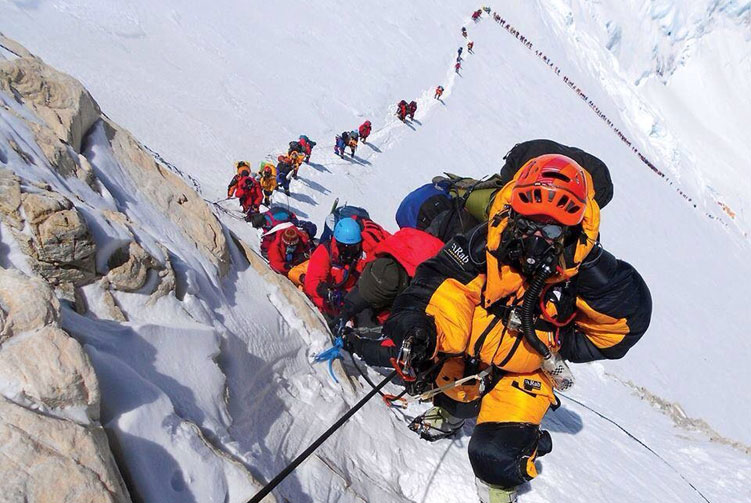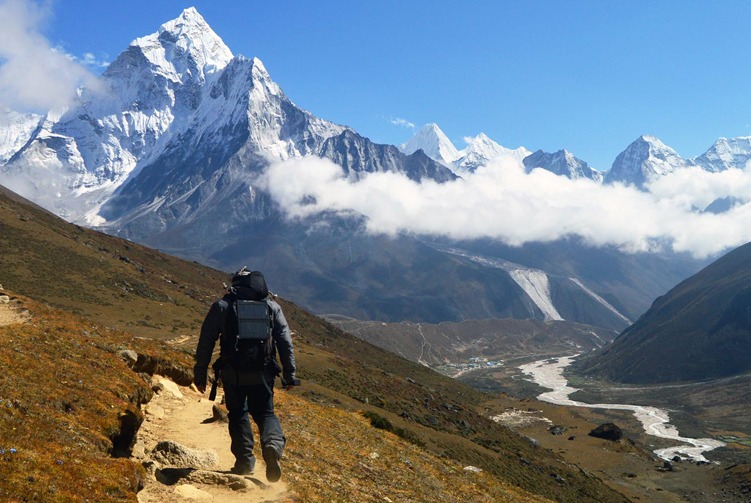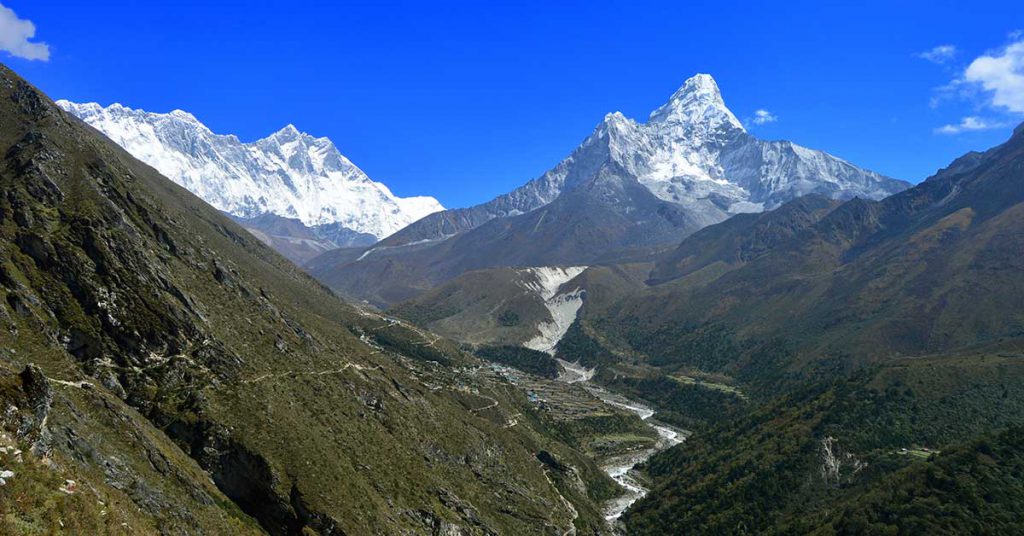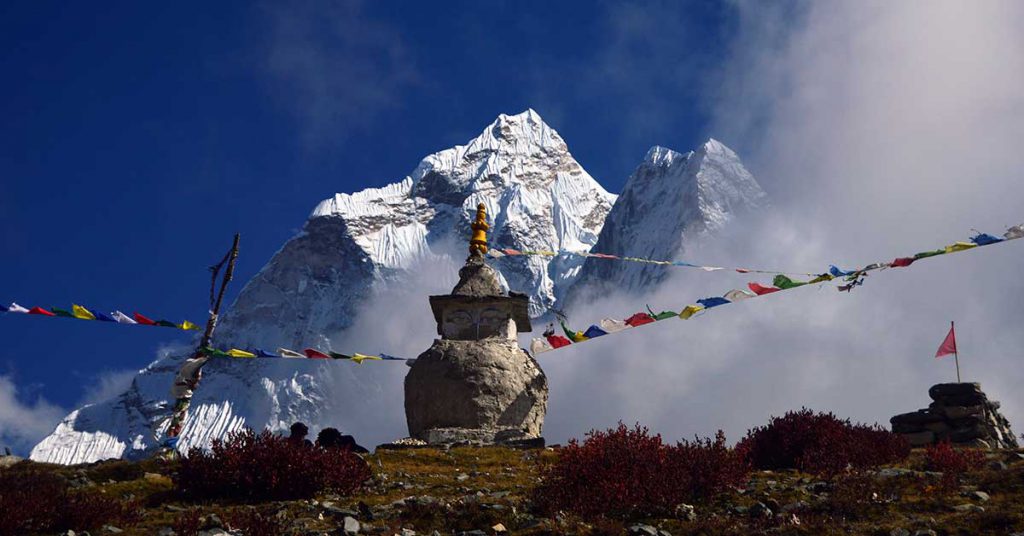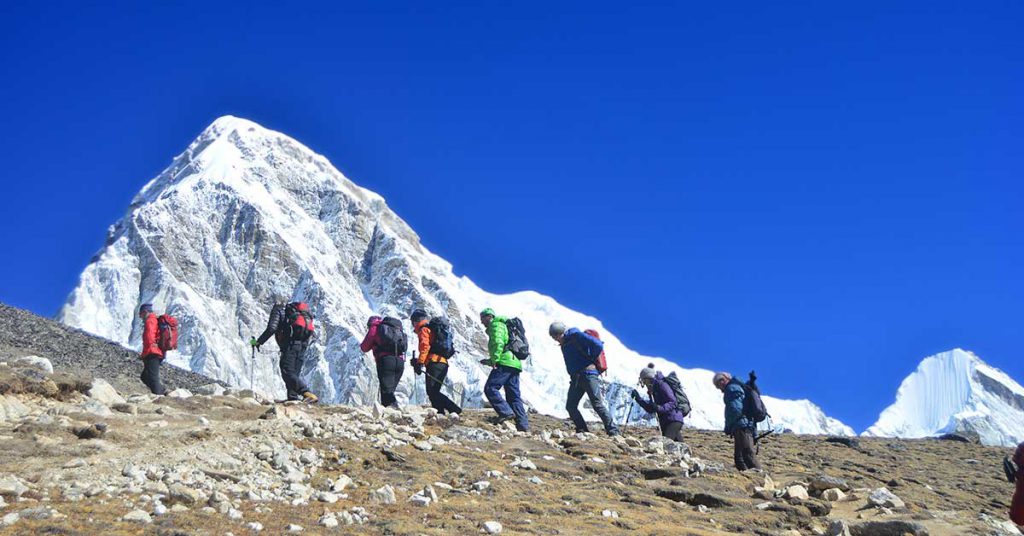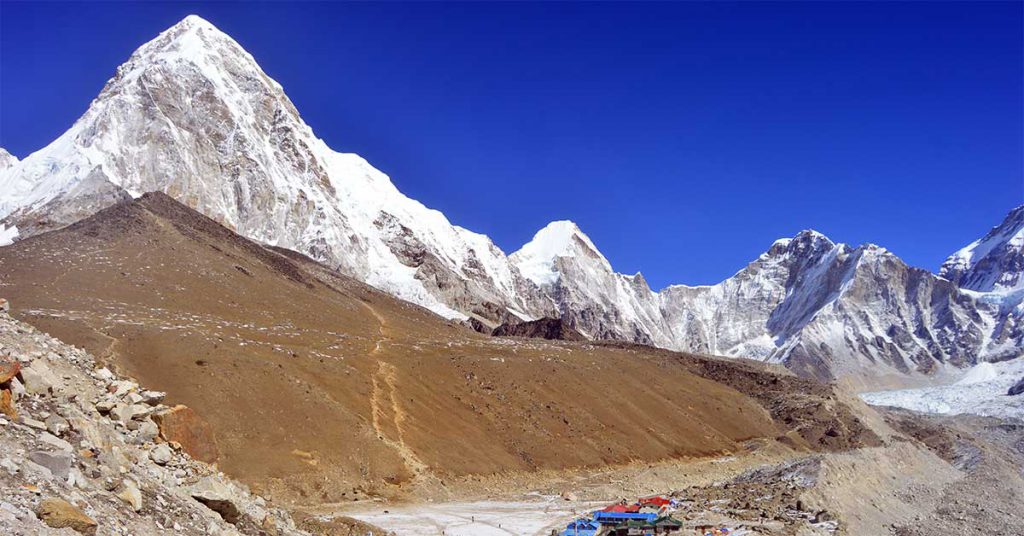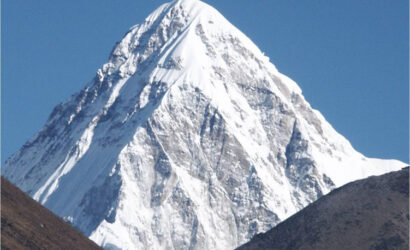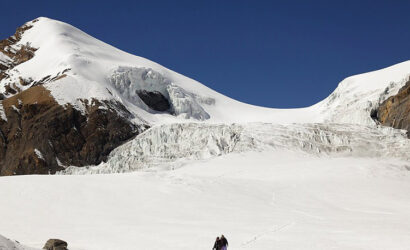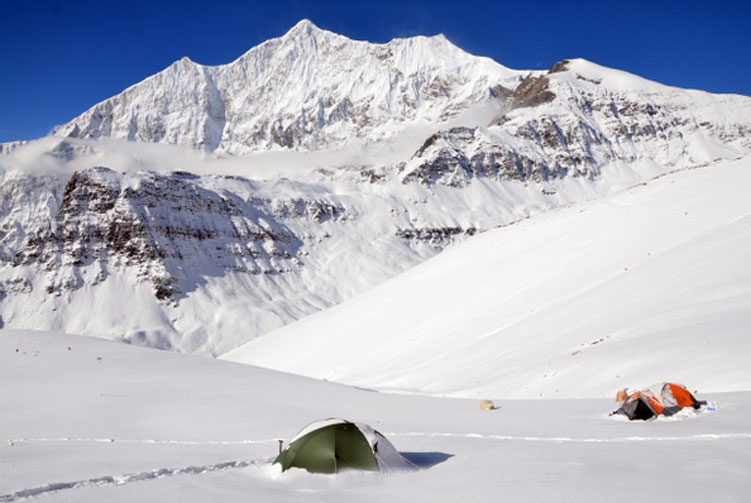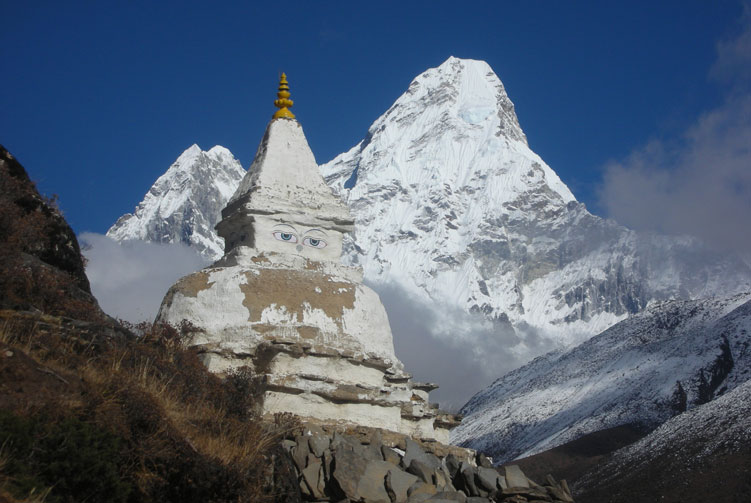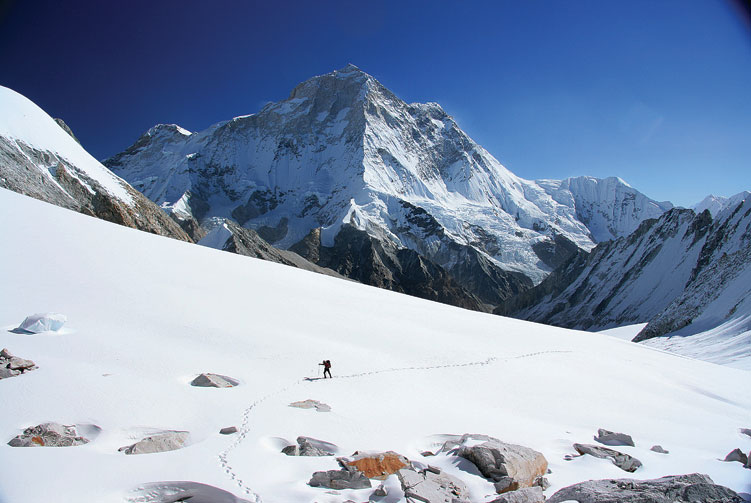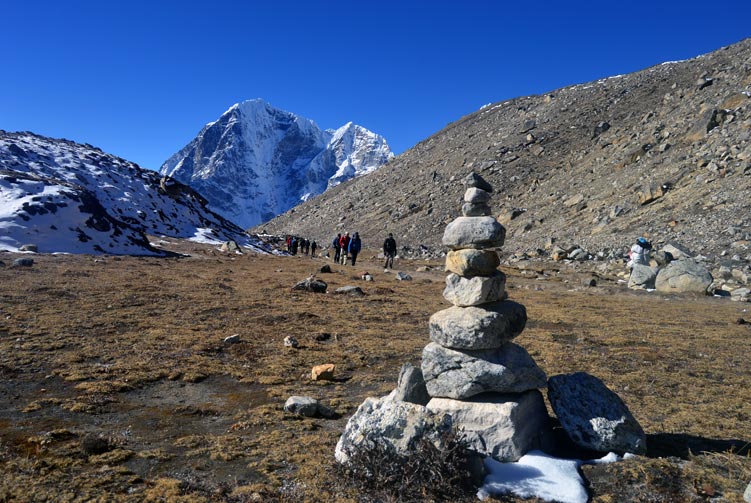Most mountaineers dream of reaching the summit of mount Everest during their lifetime. For many mountaineers a successful Everest expedition is the ultimate goal of climbing in the Nepals Himalaya. Everest expedtion via the South Face remain the most popular choice, as this route has the highest success rate.
Overview
The Everest expedition starts after Trekking to Everest Base Camp. A short walk along the moraine leads to the Khumbu Icefall, with large crevasses, which are the main obstacles on Everest expeditions. Each year, experienced Sherpas fix this section with ropes and ladders which make it easier for climbers to reach Camp 1. Everest aspirants must ascend more gradually to reach Camp 2. From here climbing on mixed snow and ice leads the way up the Lhotse Face to Camp 3. From camp 3 the climbing is on moderate mixed snow and rock, which is not easy, to the South Col (Camp 4). The route steepens after ascending snow slopes to reach the crest of the South East Ridge. A steep climb leads to the South Summit followed by the traverse to the Hillary Step and the final ridge to the summit.
Trip Highlights
- Conquer steep slopes, icy terrain, and extreme altitudes, pushing your physical and mental limits.
- Enjoy breathtaking panoramic views of the Himalayan range from the summit and along the way.
- Interact with the Sherpa people and learn about their unique culture and traditions.
- Forge strong bonds with fellow climbers and Sherpa guides during the challenging journey.
- Develop resilience, determination, and mental strength through this extraordinary adventure.
- Create memories and stories that will last a lifetime, marked by your Everest expedition.
Itinerary
Today is the day of your arrival in Kathmandu, Nepal. As soon as you come out of the Kathmandu airport, you will find our representative waiting for you in the waiting area right outside the arrival lounge. You will be warmly greeted and welcomed by the representative and led to the vehicle. Our vehicle will take you to the trip hotel, most of the time in Thamel, that is 20-30 minutes drive, depending upon traffic, from the airport.
Preparation, Briefings at Departments of tourism, Last minute shopping
After a day of wonderful immersion into Kathmandu vibes, we are ready to fly and trek into the higher elevation. We drive to airport early morning to board our flight to Lukla to enter the Everest region. About half hour of spectacular flight takes us to the small but beautiful town of Lukla where magical mountain peaks extend their warm welcome to us.
Once we prepare for the day walk, we proceed walking towards Phakding as the destination for the day. The first day of walk in the Everest region goes along the Dudh Koshi River passing through several mani walls, chhortens and beautiful landscapes. Phakding village lies beautifully on the bank of Dudh Koshi River where we spend the night. Overnight in Lodge.
It’s a beautiful day of walking into the Sagarmatha National Park. We relish the mouthwatering breakfast as a gentle breeze comforts the morning. We set off on the trek for the day and reach Monjo to enter the national park zone. After checking into the park, we head up towards Namche Bazar. Crossing suspension bridges over the river in several places; passing through forested parts and many wonderful views, we finally reach Namche Bazar. Namche Bazar is a beautiful settlement on a mountain slope with the view of Himalayan peaks right in front. It is also an important trade center in Everest region. Overnight in Lodge.
An additional day of exploring around Namche is required to acclimatize with the thinning air as we go higher. We hike to the Everest view point to get the very first glimpse of Mt. Everest along with other impressive peaks in the region. We can hike up to Khumjung if you like to. The hiking to a higher elevation will help us acclimatize properly so that we can walk further higher. We return back to Namche Bazar in the afternoon and wander around the bazar. A relaxing afternoon will reenergize and prepare us for the next day. Overnight in Lodge.
A fresh morning with the view of mountain peaks makes our breakfast even tastier. Filled with the energy, we are ready for the day to walk to Tengboche. The first section of the walk gently climbs and then goes much flatter before descending to the river and cross a suspension bridge. After crossing the suspension bridge, it is obvious that the trail is ascending towards Tengboche.
We reach Tengboche to be greeted by the spectacular view of Mt. Ama Dablam along with the view of the Mt. Everest and other peaks around. Apart from enjoying the view of the Himalayan peaks, we can explore the famous Tengboche Monastery where the first Everest Summiteer Tenzing Norgay Sherpa once lived as a monk. Overnight in Lodge
We leave the comfort of the lodge and head towards Dingboche. The walk passes through the Diboche and Pangboche villages. Pangboche village has a beautiful monastery that is the largest one in the area and has a scalp of Yeti. After exploring the monastery, we take the trail towards Dingboche.
Dingboche is a beautiful Sherpa village that stands at the elevation of 4,410 meters above sea level and projects an incredible view of the mountain peaks. This village is a common stopover place for the trekkers and climbers to Everest Base Camp, Ama Dablam and Island Peak. Overnight in Lodge.
At the elevation of 4,410 meters above sea level here and much higher to go, we are in need of an additional day to acclimatize. For the purpose, we go for a day hiking trip to a higher point near and around Dingboche. The day will bring us breathtaking views of the Himalayan peaks. We return back to Dingboche from the hike and go to explore the surrounding for a while. Overnight in Lodge.
Today is the day when we make it to the destination of this epic journey. We trek to the Everest base camp via Gorakshep after stopping for the lunch there. Gorakshep serves as our overnight site for the day. After checking in the lodge at Gorakshep, we set off on the journey to the epic Everest base camp. The trail to the base of the highest mountain in the world is full of glacial moraine and boulders. We reach the base camp and spend some wonderful time there taking pictures and absorbing the mountain vibes.
We, later, walk back to Gorakshep to stay overnight.
Climbing Period of Mount Everest.
A fresh morning with the view of mountain peaks makes our breakfast even tastier. Filled with the energy, we are ready for the day to walk to Tengboche. The first section of the walk gently climbs and then goes much flatter before descending to the river and cross a suspension bridge. After crossing the suspension bridge, it is obvious that the trail is ascending towards Tengboche.
We reach Tengboche to be greeted by the spectacular view of Mt. Ama Dablam along with the view of the Mt. Everest and other peaks around. Apart from enjoying the view of the Himalayan peaks, we can explore the famous Tengboche Monastery where the first Everest Summiteer Tenzing Norgay Sherpa once lived as a monk. Overnight in Lodge
The journey back down to Namche Bazar will be of around eight hours. Leaving the Everest and other mountains in the region far behind, we descend long hours down to Namche Bazar. We can take some relaxing stroll around Namche Bazar in the evening or just stay inside the comfort of the lodge. Overnight at a lodge.
The final day of this trek is eventually here today. We walk back to Lukla via Monjo and Phakding along the Dudh Koshi River. A round trip on the Everest Base Camp trail comes to end here. We celebrate the end of the trekking part of the journey and thank our wonderfully amazing supporting crew members for their service and effort to take us to the base camp and back safely. Overnight at a lodge.
We get ready for the flight back to Kathmandu. We board the plane at Lukla airstrip and fly back to Kathmandu. Once we land in Kathmandu airport, we go to hotel and spend the whole day at leisure on our own. Finding relieving massage, good food, souvenir shopping, and wandering around can keep you busy for the day.
A farewell dinner is scheduled for this evening. We will let you know the departure time for dinner once we reach Kathmandu.
This is an additional day in the itinerary to compensate any possible delays on the trekking or cancellation of the flights. We extremely recommend that you have at least 2 extra days after the itinerary days so to maintain any possible delays or cancellation of the flight. If everything goes without any problem, you can utilize those extra days doing some other activities.
The final day of the trip, we drive you to airport for your scheduled flight homebound or other destination. We will pick you up 3 hours prior to your flight schedule.
The Trip Cost Includes
- Airport Pick and Drop in Kathmandu by Private vehicle.
- Welcome and Farewell dinner with cultural program.
- 4 Nights Tourist Standard Hotel Accmmodation in Kathmandu with B/B basis.
- Half day guided city tour with entrance permit.
- Round Flight ticket for Kathmandu-Lukla-Kathmandu with airport TAX.
- Standard Lodge Accommodation (best available) with twin sharing basis during the trek.
- Full Board Meals (3 Meals a day) while on the trek.
- Trekking Permit and Trekker's Information Management System (TIMS) card fees.
- Professional & highly expertise government licensed holder Trekking Guide.
- 2:1 Porters to carry luggages.
- All expenses of the staffs (Guides/Porters) that includes Food, Accommodation, Salary, Insurance, Equipment during your travel period.
- All the necessary trekking gear for porters like jacket /trousers, trekking shoes, gloves, shocks, sunglasses etc.
- Friends Adventure Team's Sleeping Bag, Walking Poles and Duffel Bag, to be return after trip completed.
- Comprehensive First Aid Kit.
- Arrangement of all rescue and evacuation promptly, in Worst Condition
- Group Trekking Gears.
- Trekking Map, Friends Adventure Team's special Souvenir.
The Trip Cost Excludes
- Meals in Kathmandu.
- Any packed food/snacks, aerated drinks, energy drinks, mineral water, alcohol, cigarettes, chocolates, nutria-bars.
- All desserts, sweet things like chocolate, cake, pie, pudding.
- Items of personal nature, Laundry Expenses.
- Clothing, Packing Items or Bags, Personal Medical Kit, Personal Trekking Gears.
- Any additional staff other than specified.
- Medical and Travel Insurance and Emergency rescue by any means of Transportation including Helicopter evacuation if required.
- Rescue, Repatriation, Medicines, Medical Tests and Hospitalization expenses.
- Airfare of international flights.
- Nepal entry visa fee (Visa issuance is easy at the arrival).
- Gratuities to guide, porters and driver (Not mandatory but expected as customizetripomary thank you for the service).
- Any other item not included in "Cost Includes" Section.
Frequently asked Questions
An Everest Expedition refers to the journey to climb Mount Everest, the world’s highest peak, standing at 29,032 feet (8,848 meters) above sea level.
Mount Everest is situated in the Himalayas, on the border between Nepal and Tibet (China).
Climbing Everest is extremely challenging due to its high altitude, severe weather conditions, and technical climbing requirements. It requires significant mountaineering skills, physical fitness, and mental resilience.
The entire expedition typically lasts around two months, including acclimatization, base camp setup, and the ascent. The actual climb to the summit can take a few weeks, depending on weather conditions.
The cost varies widely, ranging from $30,000 to over $100,000. Factors influencing cost include the expedition organizer, services provided, permits, equipment, and logistical support.
The primary climbing season is during spring (April to June) and, to a lesser extent, during the autumn season (September to November). Spring is considered the best time due to milder weather conditions.
Yes, climbers must obtain a permit from the respective government authorities, either Nepal or China, depending on the route. The permits are expensive and contribute to conservation efforts.
The two main routes are the South Col route in Nepal and the North Col route in Tibet. The South Col route is more popular and sees the majority of climbers.
Everest presents various dangers, including avalanches, crevasses, extreme weather, high-altitude sickness, and the Khumbu Icefall. The risks make it crucial for climbers to be experienced and well-prepared.
Thousands of climbers have reached the summit since Sir Edmund Hillary and Tenzing Norgay first succeeded in 1953. However, the exact number changes each climbing season.
The death rate on Everest varies each year but has historically been around 1-2% of climbers. Causes include altitude sickness, avalanches, falls, and other mountaineering hazards.
Yes, Everest expeditions have raised concerns about environmental impact, including waste and pollution. Organizations and climbers are increasingly focused on “Leave No Trace” practices.
Most climbers use supplemental oxygen above a certain altitude (usually above 26,000 feet or 8,000 meters) to cope with the thin air and reduce the risk of altitude sickness.
Climbing Everest requires advanced mountaineering skills, physical fitness, and experience at high altitudes. Climbers often need to have successfully summited other peaks before attempting Everest.
The Nepalese and Chinese governments regulate Everest expeditions. They issue permits, set rules, and manage base camp facilities to ensure safety and minimize environmental impact.
Acclimatization is a crucial process where climbers gradually expose themselves to higher altitudes to allow their bodies to adjust to reduced oxygen levels. This involves ascending to higher elevations and returning to lower altitudes for rest.
The Khumbu Icefall is a highly crevassed and dynamic glacier section near Everest Base Camp. It is one of the most dangerous parts of the climb, with constantly shifting ice blocks and the risk of serac falls.
Essential equipment includes specialized mountaineering gear, high-altitude clothing, a down suit, crampons, ice axes, ropes, and supplemental oxygen. Proper gear is crucial for safety and survival.
There are two main base camps: the South Base Camp in Nepal (used for the South Col route) and the North Base Camp in Tibet (used for the North Col route).
There is no strict age limit, but climbers should be in excellent physical condition. Many expeditions have age restrictions, typically requiring climbers to be at least 18 years old.
Climbers spend only a short time at the summit, typically 15-30 minutes, due to the limited oxygen supply and harsh conditions. The descent is equally challenging and requires careful attention.
Communication at higher altitudes is challenging. Base camps are equipped with satellite phones and internet, but as climbers ascend, communication becomes limited. Some climbers use satellite phones or radios for emergencies.
Waste management is a significant concern. Climbers and expedition organizers are increasingly adopting responsible practices, such as carrying down their waste, including human waste, and participating in clean-up efforts.
Sherpas, the local guides and climbers, face significant risks during Everest expeditions. They are crucial to the success of climbs, often taking on roles like fixing ropes and carrying heavy loads through dangerous sections.
Organizations and climbers are working to minimize the environmental impact of Everest expeditions. This includes cleaning up litter, enforcing waste disposal regulations, and promoting sustainable practices.
While it is theoretically possible, attempting Everest independently is highly discouraged due to the technical challenges, risks, and the complex logistics involved. Most climbers join organized expeditions for safety and support.
Success rates vary each season but typically range from 50% to 70%. Factors influencing success include weather conditions, climber experience, and the effectiveness of expedition planning and execution.
The youngest person to summit Everest is Jordan Romero at 13 years old, and the oldest is Yuichiro Miura at 80 years old. These records can change, so it’s essential to check the latest information.
Weather on Everest can be extreme and unpredictable. Climbers need to navigate through windows of favorable weather for a safe ascent and descent. The jet stream and monsoon seasons can significantly impact climbing conditions.
Sherpas play a critical role as guides, support staff, and climbers. They are essential for fixing ropes, carrying supplies, and providing crucial knowledge about the mountain. Many climbers rely on Sherpas for a successful ascent.
Climbers undergo intense physical training, including cardiovascular workouts, strength training, and high-altitude simulation. They also practice technical climbing skills, such as ice and rock climbing, to prepare for Everest’s challenges.
Altitude sickness symptoms include headaches, nausea, dizziness, and fatigue. The primary treatment is to descend to a lower altitude. Oxygen and medications may be used, but descent is the most effective solution.
Climbers use supplemental oxygen to compensate for the reduced oxygen levels at high altitudes. Oxygen is carried in tanks and is crucial for preventing altitude sickness and ensuring the safety of climbers.
Rescue services are available, but they can be challenging due to the high altitude and extreme conditions. Helicopter rescues are limited at higher altitudes, and climbers must often rely on fellow climbers and Sherpas for assistance.
Staying overnight at the summit is highly discouraged due to the extreme conditions and limited resources. Climbers typically descend to lower camps after reaching the summit to ensure their safety.
The Hillary Step is a rocky outcrop near the summit that poses a technical climbing challenge. While it’s not the most dangerous part, climbers must navigate it carefully, especially during the crowded summit push.
Climbers use ladders to traverse crevasses in the Khumbu Icefall. This section requires careful navigation, and climbers must move quickly due to the ever-changing nature of the icefall.
Base camp doctors are crucial for assessing climbers’ health, managing altitude-related issues, and providing medical support. They play a key role in ensuring climbers are fit for the ascent.
Mental resilience is vital for Everest climbers. They undergo psychological training to cope with stress, isolation, and the mental demands of high-altitude mountaineering. Positive mindset and mental preparedness are essential.
Climate change has led to glacier retreat and changes in weather patterns on Everest. This can affect climbing conditions, increase the risk of avalanches, and impact the overall environment of the mountain.
Climbers need to obtain permits from the respective government authorities (Nepal or China). The process involves submitting necessary documents, adhering to regulations, and paying fees, which contribute to conservation efforts.
Climbers face sub-zero temperatures, especially at higher altitudes. They use specialized cold-weather gear, including insulated clothing, boots, and gloves, to protect themselves from frostbite and hypothermia.
Communication can be challenging due to the mountainous terrain. Climbers often use radio communication, satellite phones, or messaging devices. However, these can be affected by extreme weather and altitude.
Yaks and porters transport essential supplies, gear, and equipment from lower elevations to higher camps. They play a crucial role in supporting climbers by lightening their load and facilitating the logistics of the expedition.
Rest days and acclimatization rotations help mitigate fatigue. Climbers pace themselves, stay hydrated, and consume high-calorie meals. Proper acclimatization is crucial for building endurance and reducing the risk of exhaustion.
Climbers are encouraged to follow ethical practices, including minimizing environmental impact, respecting local culture, and practicing responsible tourism. This includes proper waste disposal, supporting local communities, and respecting sacred sites.
Emergency situations, such as medical issues or extreme weather events, require quick and coordinated responses. Expedition teams have emergency protocols in place, and communication with base camp is vital for swift assistance.

